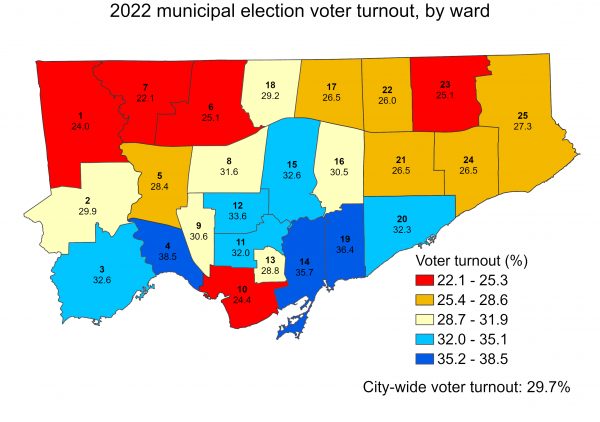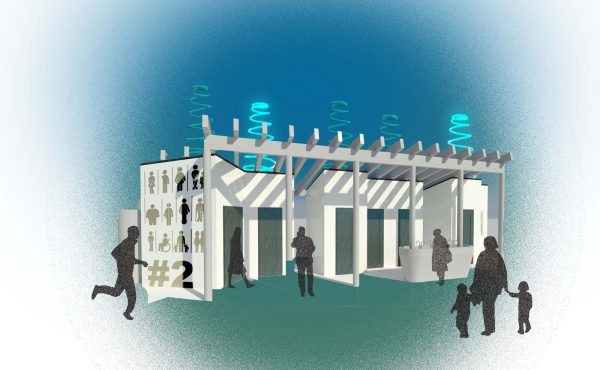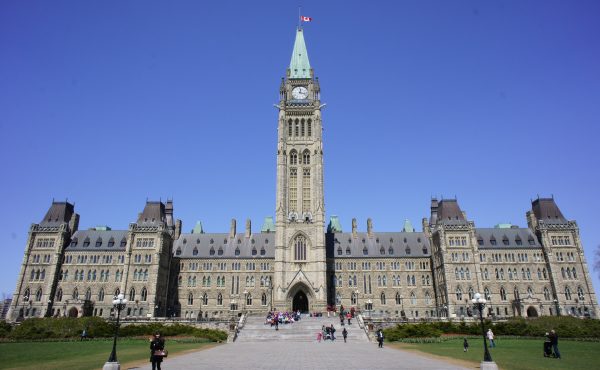Ever since John Tory was elected mayor of Toronto in 2014, voter turnout in municipal elections has been in decline. In 2010, the year Rob Ford was elected mayor, turnout was 50.4 percent. Four years later, 54.7 percent of all eligible voters went to the polls to elect a new chief magistrate. However, in 2018, just 40.9 percent bothered to vote, and in 2022, turnout fell further, to just 29.7 percent.
With the recent release of detailed voter statistics from the 2022 municipal election in the Toronto Open Data catalogue, it is now possible to see how much turnout dropped in each ward.
Voter turnout is typically the highest in Toronto’s most affluent wards and neighbourhoods, though Rob Ford’s 2010 campaign engaged many voters from the city’s inner suburbs who may not voted otherwise. Since 2014, citizens have been most likely to vote in Midtown Toronto, central Etobicoke, and in the city’s east end, particularly in Toronto-Danforth and Beaches-East York. The lowest levels of voter turnout have been in northern Etobicoke, parts of North York, in Scarborough, and in the Spadina-Fort York downtown ward. The 2022 election was no different.

There is no single explanation for these trends, though there are several contributing factors. In Spadina-Fort York, a young, more transient population is less likely to become engaged in civic democracy, even though issues such as housing, access to parks, recreation, and schools, as well as transit and safe walking and cycling route are municipal issues that most certainly matter to young households. In Toronto’s inner suburbs, precarious working environments, long commutes, poor transit, and difficulty accessing city services are matters that discourage civic engagement, which also makes it easy for local politicians to ignore them.
In 2022, the ongoing COVID-19 pandemic, a dull mayoral race where the leading challenger had little name recognition and no lawn signs, and perhaps a general malaise resulted in the lowest voter turnout in decades. In every ward, the voter turnout fell from 2018 (itself an election marred by the sudden decision by the newly elected Ontario PC government to cut city council by almost half, during the campaign period), though the drop was not uniform across the city. Ward 7 Humber-Black Creek saw the biggest drop in turnout, from 34.6% to just 22.1%, a decline of over one-third. That ward had the second-lowest voter turnout in 2018 and the lowest turnout in 2022.
Ward 4, which featured a three-way race for city council between incumbent Gord Perks, former John Tory staffer Siri Agrell, and Parkdale activist Chemi Lhamo, had the smallest decline in voter turnout and the highest ward turnout in 2022. Other wards that featured competitive council races, including Ward 5 York South-Weston, Ward 3 Etobicoke-Lakeshore, Ward 11 University-Rosedale, and Ward 20 Scarborough Southwest, all saw smaller declines in voter turnout, though Ward 5 still had a lower-than-city-average turnout, with just 28.4% of eligible electors voting.

For now, it’s unclear what voter turnout will look like in the upcoming mayoral byelection in June. Traditionally, council by-elections have especially low engagement (Ward 22 councillor Nick Mantas was elected with just 17.9% of eligible voters bothering to cast a ballot in 2021), but a city-wide race for an open mayoral seat might be different, especially with media attention and a clear choice of recognizable candidates who campaign on distinct visions for the city’s future. A mayoral campaign that inspires voters in traditionally low-turnout wards in particular would be especially welcome.




